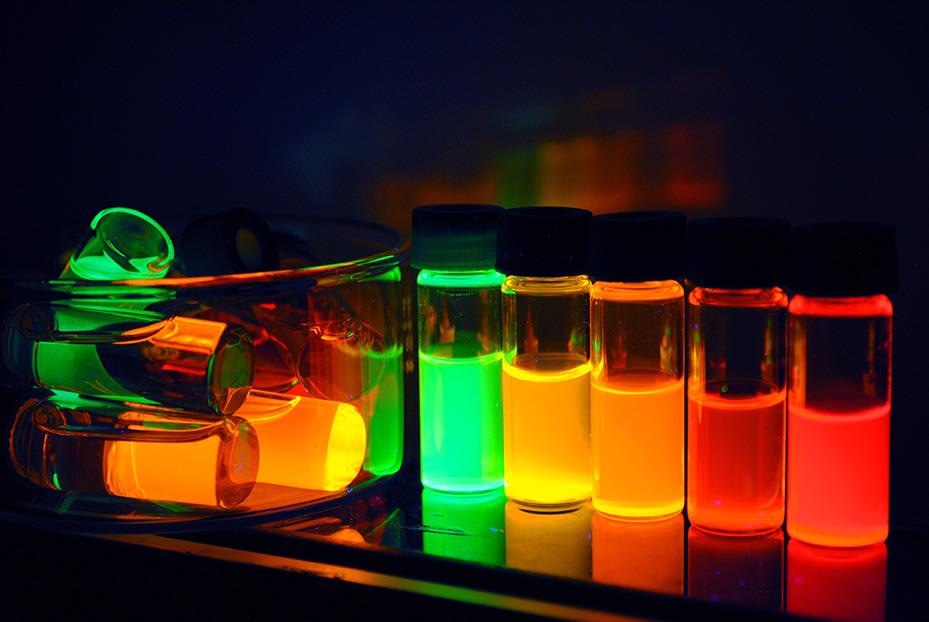A new study published in Science magazine offers an outline of nearly 30 years of research performed on colloidal quantum dots.
 The tiny specs of matter called quantum dots can be tuned to emit light in specific wavelengths. That is just one quality that makes them valuable in a range of technology applications. Image Credit: Los Alamos National Laboratory.
The tiny specs of matter called quantum dots can be tuned to emit light in specific wavelengths. That is just one quality that makes them valuable in a range of technology applications. Image Credit: Los Alamos National Laboratory.
The study evaluates the technological advances for these nanometer-sized specs of semiconductor matter and weighs the unresolved difficulties on the way to extensive commercialization for this potential technology that could find applications in everything right from TVs to sunlight collectors that are very efficient.
Thirty years ago, these structures were just a subject of scientific curiosity studied by a small group of enthusiasts. Over the years, quantum dots have become industrial-grade materials exploited in a range of traditional and emerging technologies, some of which have already found their way into commercial markets.
Victor I. Klimov, Study Co-Author and Leader, Los Alamos National Laboratory
Klimov is the leader of the team performing quantum dot research at Los Alamos National Laboratory.
Several advances explained in the Science article were started at Los Alamos, including the first illustration of colloidal quantum dot lasing, breakthrough research into quantum dot light-emitting diodes (LEDs), luminescent solar concentrators, the discovery of carrier multiplication, and the latest studies of single-dot quantum emitters.
Sophisticated colloidal chemistry, can help manipulate the internal structure and dimensions of quantum dots with near-atomic accuracy, which enables highly precise control of their physical properties and thus behaviors in practical devices.
Several efforts are being made to achieve practical applications of colloidal quantum dots employing size-controlled tunability of their emission color and high-emission quantum yields closer to the perfect 100% limit. Such properties seem to be appealing for lighting and screen displays — the technologies where quantum dots are utilized as color converting phosphors.
Quantum dots exhibit narrowband and spectrally tunable emission, thus enabling enhanced color purity and coverage of the complete color space when compared to the present phosphor materials. A few of these devices, including quantum dot TVs, have earlier attained technological maturity and are commercially available.
The next step is to make LEDs that are technologically viable and powered by electrically driven quantum dots. The Science review explains several methods to realize these devices and analyzes the current difficulties.
Quantum LEDs have already achieved magnificent brightness and nearly perfect efficiencies next to the theoretically defined limits. A majority of these advances have been pushed by ongoing progress in comprehending the performance-limiting factors like nonradiative Auger recombination.
Moreover, the article debates the status and difficulties of solution-processable quantum dot lasers.
Making these lasers available would benefit a range of technologies, including integrated photonic circuits, optical communication, lab-on-a-chip platforms, wearable devices, and medical diagnostics.
Victor I. Klimov, Study Co-Author and Leader, Los Alamos National Laboratory
Scientists from Los Alamos have achieved crucial advances in this area, such as the interpretation of mechanisms for light amplification in colloidal nanostructures and the initial illustration of a lasing effect using these materials.
The primary current challenge is demonstrating lasing with electrical pumping. Los Alamos has been responsible for several important milestones on the path to this objective including the realization of optical gain with electrical excitation and the development of dual-function devices that operate as an optically pumped laser and a standard electrically driven LED.
Victor I. Klimov, Study Co-Author and Leader, Los Alamos National Laboratory
Moreover, quantum dots could find wider potential use in technologies such as light sensing and solar harvesting. Thanks to their tunable bandgap, they could be designed to target a specific range of wavelengths, which is particularly appealing for achieving low-cost photodetectors for the infrared spectral range.
As far as the domain of solar energy technologies is concerned, colloidal quantum dots have been utilized as active elements of both luminescent sunlight collectors and solar cells.
Concerning photovoltaics (PV), the method of quantum dot could be utilized to achieve a new generation of affordable, thin-film PV devices made by scalable solution-based methods like roll-by-roll processing.
Besides, they could allow conceptually new photo conversion schemes obtained from physical processes that are exclusive to ultrasmall “quantum-confined” colloidal particles. Carrier multiplication is one such process that produces multiple electron-hole pairs with the help of a single absorbed photon.
This process was initially reported by Los Alamos scientists in 2004 and has been the subject of intense studies due to its applications in both solar photochemistry and PVs.
Klimov stated, “Another highly promising area is quantum dot luminescent solar concentrators. Using the LSC approach, one can, in principle, convert standard windows or wall sidings into power-generating devices. Along with roof-top solar modules, this could help supply an entire building with clean energy. While the LSC concept was introduced back in 1970s, it truly flourished only recently due to introduction of specially engineered quantum dots.”
Scientists at Los Alamos have assisted in various essential developments to the LSC field, which include the development of practical methods for handling the issue of light self-absorption and designing high-efficiency bi-layer (tandem) devices. Numerous start-ups, including a Laboratory spin-off, UbiQD Inc., have been actively working toward the commercialization of a quantum dot LSC technology.
This study was financially supported by the Laboratory Directed Research and Development (LDRD) at Los Alamos National Laboratory and DOE and U.S. Department of Energy Office of Science.
Journal Reference:
García de Arquer, F. P., et al. (2021) Semiconductor quantum dots: Technological progress and future challenges. Science. doi.org/10.1126/science.aaz8541.